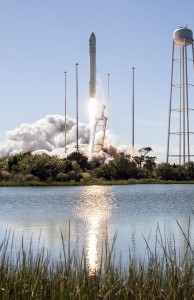
ISRO has announced that it is all set to launch a record number of 22 satellites in a single mission next month. The satellites will be launched from Satish Dhawan Space Centre at Sriharikota. ISRO will use Polar rocket PSLV C34 for the launch.
Of these 22 satellites that ISRO will launch, three are Indian and the rest are commercial satellites those from US, Canada, Indonesia and Germany.
“After the current reusable launch vehicle, the next experiment what we have to do we have to worry about that. Other than that, next month we have a launch where we will be launching about 22 satellites. Also one of a cartographic series satellite will be launched,” ISRO Chairman Kiran Kumar said while speaking at an event organized by Federation of Karnataka Chambers of Commerce and Industry.
“The launch is scheduled during the end of next month,” he added.
In 2008, the Indian space agency had sent ten satellites into orbit in a single mission.
According to Kiran Kumar, following the PSLV C34 launch, ISRO will launch a scatterometer as well as a geostationary satellite INSAT 3DR that will provide vertical temperature and humidity profile.
On May 23, 2016, ISRO had successfully flight-tested its first-ever indigenous space shuttle Reusable Launch Vehicle – Technology Demonstrator (RLV-TD) from Sriharikota spaceport in Andhra Pradesh. This reusable rocket is expected to drastically reduce the cost of space missions in days to come.
“We have located the place where the vehicle is floating. The landing was soft and the vehicle did not break,” K. Sivan, a scientist involved in the latest project, told AFP.
“The mission went off as planned and data from the experiment showed that we have achieved its objectives and demonstrated the RLV technology.”
After the successful launch, Indian Prime Minister Narendra Modi praised the “industrious efforts” of ISRO scientists.
Founded in 1969 and headquartered in Bengaluru, ISRO is the space agency of India that was created with an aim to lead India in space science research and planetary exploration. The vision of ISRO is to “harness space technology for national development”.
Prior to ISRO, Indian National Committee for Space Research (INCOSPAR), created in 1962, was responsible for managing space research program in India. India’s Department of Space, which reports to the Prime Minister of India, manages all the activities of ISRO.
India’s first satellite, Aryabhata, was made by ISRO. Named after Indian mathematician Aryabhata, the satellite was launched in 1975 by the Soviet Union. In 1980, ISRO got success in placing the Rohini satellite in orbit using an Indian-made launch vehicle, SLV-3. Over the years, ISRO successfully developed two other Rockets – the Polar Satellite Launch Vehicle (PSLV) and the Geosynchronous Satellite Launch Vehicle (GSLV) – for launching satellites into polar and geostationary orbits respectively.
In the past three decades, these rockets have put several communications and earth observation satellites in orbits.
ISRO grabbed the attention of the whole world by creating lunar orbiter Chandrayaan-1and Mars Orbiter Mission (MOS). Chandrayaan-1 was sent to moon on 22 October 2008. MOS also got success in entering the Mars orbit on 24 September 2014, thus making India the world’s first nation to succeed on its first attempt. India also became the first space agency in Asia and fourth in the world to have successfully reached Mars orbit.
In May 2016, India successfully launched its first-ever indigenous space shuttle – the Re-Usable Launch Vehicle – Technology Demonstrator (RLV-TD) from Sriharikota in Andhra Pradesh.
RLV-TD, the country’s first winged-body aerospace vehicle, is being said to be the ISRO’s first step towards developing a reusable launch vehicle that would be capable of sending spacecraft into orbit and then returning to the Earth. After this technology is developed completely, it would be possible to launch spacecraft, including satellites, into space and make them re-enter earth’s atmosphere. During re-entry, the spacecraft would withstand extreme pressure and heat conditions, and then land in at an intended spot. The technology would substantially reduce costs of launch of space vehicles.
ISRO is currently working on several other projects, including development of GSLV Mk III, ULV, reusable launch vehicle, human spaceflight, interplanetary probes, solar spacecraft mission, etc.
